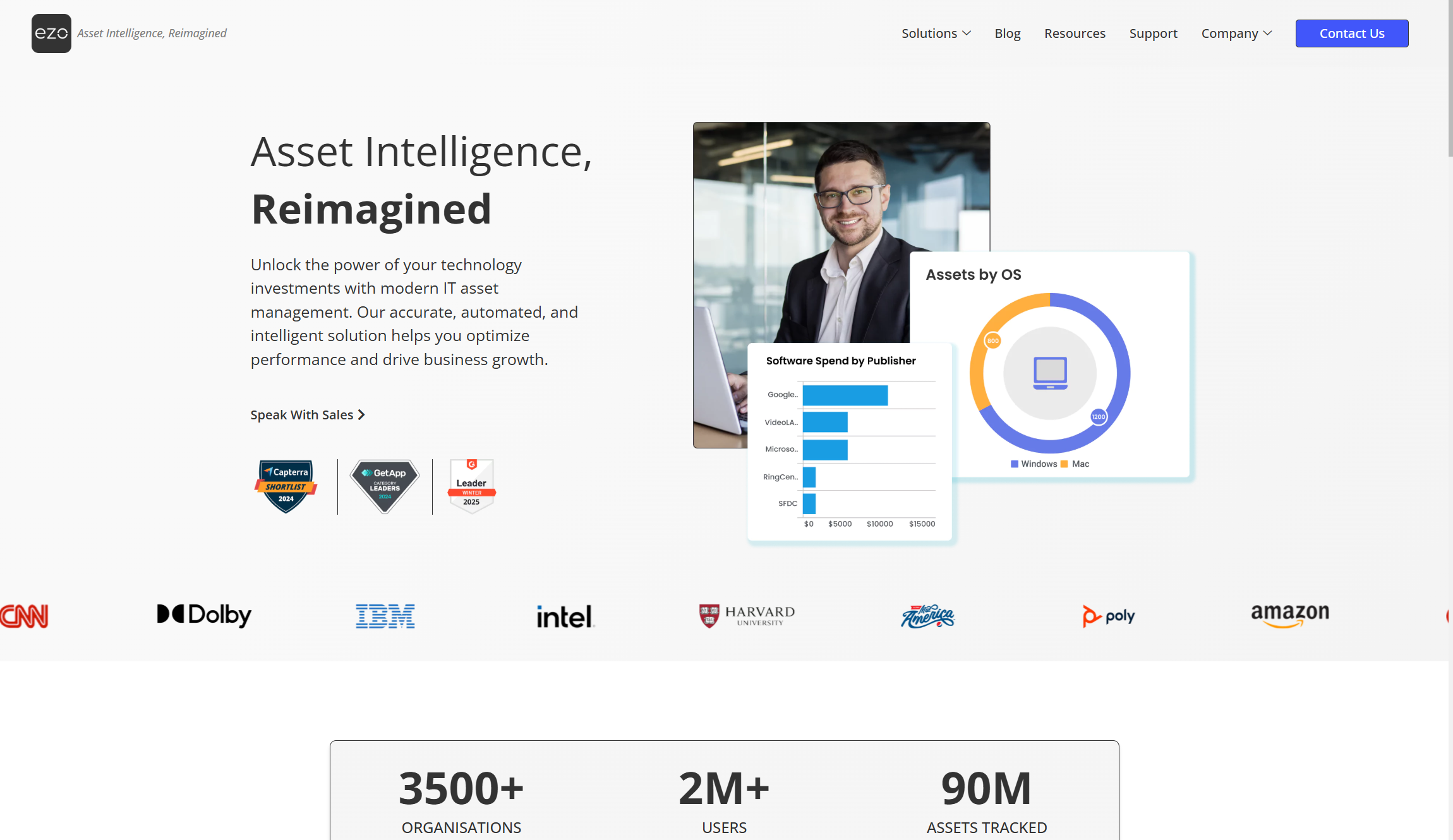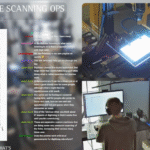
Why you can trust TechRadar
We spend hours testing every product or service we review, so you can be sure you’re buying the best. Find out more about how we test.
Ezo is a surprisingly straightforward IT asset management software for inventory across multiple locations. The platform provides clear visibility into asset lifecycles, from acquisition to retirement. Its clean interface avoids overwhelming users with unnecessary complexity. We were impressed with how quickly we could implement the system during testing and start tracking equipment without extensive training.
The software shines in its asset tracking capabilities. It allows you to assign equipment to users and maintain accountability throughout the organization. During our tests, Ezo’s QR code scanning worked flawlessly, making check-ins and check-outs a breeze. The reporting tools offered meaningful insights into asset use, though the dashboard could have been more intuitive for first-time users.
Ezo does have some weaknesses in its mobile experience. We noticed a few performance issues during testing. There was lag when processing multiple items at once, but the mobile interface feels less polished than the desktop version in general. Despite these minor drawbacks, the overall value remains strong. Especially for remote businesses with inventory management needs across multiple locations, Ezo could be a keeper.
Ezo’s preventive maintenance features were a point of highlight during testing. They help you schedule and track regular equipment upkeep. We appreciated the automated alerts for upcoming maintenance tasks, which could extend the lifespan of assets. Being able to generate custom reports also helps you analyze inventory data on demand. However, we wish there were more advanced filtering options for different scenarios.
Ezo: Plans and pricing
Ezo has a tiered pricing system for businesses of all sizes. The Basic plan starts at $9.99 per user monthly (billed annually). It includes core asset tracking, limited to 500 assets, and basic reporting. But we found that the Professional plan at $19.99 per user monthly offers the best value. It provides unlimited asset tracking, advanced reporting, and maintenance scheduling, which greatly improved our asset management workflow.
Enterprise pricing comes through custom quotes. This includes extra features like API access, dedicated support, and custom integrations with current business systems. Ezo also offers a 14-day free trial for all new users. All plans come with free updates and standard customer support. However, premium support is only available at higher tiers.
Ezo: Features
Ezo offers a complete set of asset management tools that can simplify inventory tracking and maintenance scheduling for any organization. We found the platform’s easy-to-use interface very helpful quick implementation across departments. But beyond that, here are the features that stood out to us the most:
Asset tracking
The core asset tracking feature lets you document equipment details, location, and user assignments. We were impressed by how easily we could create and attach QR codes to physical assets. This could make check-ins and check-outs much more efficient. The system also retains a full history of each asset, including maintenance records and location changes.
Maintenance management
Ezo’s maintenance scheduling feature was a big hit during our testing. You can set recurring maintenance tasks based on time or usage. The system automatically generates work orders and notifies team members. This could help you avoid costly repairs and extend the life of your assets by addressing issues early on.
Mobile accessibility
Ezo has a mobile app for teams working in the field or from different locations, available on both iOS and Android. It manages basic tasks like asset scanning, status updates, and location changes well in most cases. The option to take photos of assets and link them to inventory records could be helpful during equipment audits. But, we noticed synchronization delays in areas with weak connectivity and the app lacks many features available to desktop users.
User management
The platform has a strong user management system in place. It lets administrators assign specific permissions and access levels to team members. We loved the option to create custom roles that fit different organizations. Plus the audit trail feature tracks changes per user, assisting with compliance.
Ezo: Analytics
Ezo’s reporting features offer detailed insights into asset use, maintenance history, and inventory status. In our tests, the pre-built report templates met most of business scenarios. They provided quick access to depreciation schedules, maintenance compliance, and asset allocation metrics. Being able to schedule automated report delivery via email was a nice touch.
A custom report builder lets you create tailored analyses. You can select specific data points and visualization options to answer specific business questions. We liked the easy drag-and-drop interface. It allowed us to build complex reports without any SQL knowledge. However, we found that generating reports with very large datasets sometimes slowed performance. Some optimization here could help organizations with extensive inventory records.
Ezo: Ease of use
We found Ezo’s interface very easy to use. We were able to set up quickly and start tracking equipment without much training. QR code scanning worked perfectly during our tests. It made asset check-ins and check-outs much faster than manual methods. However, some user reviews mention an initial learning curve, especially when using the advanced search function.
Ezo’s mobile app offers key features for teams in the field, but we noticed some performance issues during testing. We liked being able to take photos of assets and attach them to inventory records during audits. This can be very helpful for keeping accurate documentation.
But despite a few minor UI issues, our overall user experience was intuitive. Most professionals can quickly adapt to the platform’s main features, then explore advanced use cases over time.
Ezo: Support
Ezo provides various support options: email, phone, and chat. Their team is available on weekdays from 7 am to 5 pm US Eastern time. They also offer after-hours help for urgent issues.
In our evaluation, we found the customer service team very responsive. They typically reply within the same day and focus on finding solutions to our questions. Each license includes up to 90 minutes of onboarding help. This allowed us to quickly learn key features like asset tracking workflows, reporting capabilities, and best practices to optimize our processes.
Ezo: Security
Ezo shows a strong commitment to security with several key certifications. These include ISO 27001, SOC 2 Type 2 compliance, and CSA STAR Level 1 certification. Plus the platform runs on Amazon Web Services (AWS), a top cloud computing service known for its strong security measures.
Ezo: The Competition
There are several alternatives to Ezo, like Asset Panda, Sortly, and GoCodes. Each has similar asset tracking features but with different pricing and capabilities.
Asset Panda is a cloud-based platform that excels in warranty tracking and multi-location management. Sortly specializes in inventory management, offering great expiration date tracking and reminder features. GoCodes stands out for its strong equipment tracking and workflow management, appealing to organizations that want to prevent lost or stolen tools.
Ezo’s pricing places it in the mid-range compared to its competitors. But ultimately, choosing the right platform depends on specific needs. Ezo generally offers a good balance of functionality and value for most business asset management needs.
Ezo: Final Verdict
Ezo offers a strong asset management experience. It balances ease of use with effective tracking. The platform shines particularly in showing asset lifecycles. Key features include QR code scanning, maintenance scheduling, and reporting tools that give insights into asset use.
We found some limits in the mobile app, plus some user interface areas could use an upgrade. Still, the overall value is high. Especially for businesses facing inventory challenges across many locations or with remote workers.
We’ve also listed the best software asset management tool.
Read the full article here













